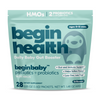Combo Feeding + Solids: How to Balance Breastmilk, Formula, and Food for Gut Health
share this article

If you are combo feeding, offering both breastmilk and formula while starting solids, you are not alone. Combo feeding is incredibly common and can be a flexible, nourishing approach for both babies and parents. The key question many parents ask is, how do you balance breastmilk, formula, and solid foods to support gut health?
Here is how to navigate combo feeding with solids while supporting your baby’s digestion, microbiome, and overall gut health.
Why Gut Health Matters During Combo Feeding
The first year of life is when your baby’s gut microbiome develops rapidly. A diverse and balanced microbiome helps support:
-
Digestion
-
Pooping patterns
-
Immune system development
-
Long-term gut health and may support reducing allergy development (1)
Both breastmilk and formula contribute to gut development but they are not the same. How you introduce solids alongside them can either support or challenge gut balance.
How Breastmilk Supports Gut Health
-
Contains Human Milk Oligosaccharides (HMOs) that feed beneficial bacteria like Bifidobacterium
-
Provides antibodies and immune factors that protect the gut lining
-
Helps maintain a softer, more acidic gut environment that favors good bacteria (2)
How Formula Supports Gut Health
-
Modern formulas are designed to mimic breastmilk in macronutrients but do not contain the same variety or volume of HMOs unless added.
-
Some formulas now include 2’-FL HMO, a key prebiotic also found in breastmilk, but most do not match the full diversity of HMOs.
-
Formula still provides essential nutrition and supports growth but can lead to a slightly different gut microbiome profile (3).
How to Balance Breastmilk, Formula, and Solids for Gut Health
1. Prioritize Milk First (Until 12 Months)
-
Breastmilk or formula should still provide most of your baby’s calories until age one.
-
Solids complement milk, rather than replace it, in the first year.
2. Support the Gut Microbiome with Solids
-
Choose fiber-rich, prebiotic foods as some of baby’s first solids:
-
Mashed beans, lentils, peas
-
Avocado
-
Bananas
-
Cooked carrots or sweet potatoes
-
These foods feed beneficial gut bacteria and support stool regularity as solids increase.
3. Consider a Prebiotic + Probiotic Supplement
-
Especially helpful for combo-fed or formula-fed babies, since formula-fed gut microbiomes have fewer Bifidobacterium species compared to breastfed babies (3).
-
Products like Beginbaby Prebiotics + Probiotics add 2’-FL HMOs plus beneficial strains like Bifidobacterium infantis to help bridge the gap in microbiome development.
4. Balance Hydration as Solids Increase
-
As solids ramp up, make sure your baby is still getting plenty of breastmilk or formula.
-
Offer small amounts of water with meals to support digestion and prevent constipation.
5. Watch for Constipation During the Transition
-
Include digestion-friendly foods like kiwi, prunes, pears, and add healthy fats like olive oil or avocado to help stools stay soft.
-
Daily prebiotics can help maintain regular pooping as solids increase.
Sample Daily Routine for Combo Feeding + Solids
|
Time |
Meal |
|
Morning |
Breastmilk or formula feed |
|
Mid-morning |
Solids: oats + banana + avocado |
|
Lunch |
Breastmilk or formula feed |
|
Afternoon |
Solids: lentils + sweet potato |
|
Evening |
Breastmilk or formula feed |
|
Before bed |
Breastmilk or formula feed |
Breastmilk or formula remains the foundation, while solids complement with fiber, nutrients, and gut-friendly variety.
Summary
Combo feeding with solids can absolutely support healthy gut development when done with intention. Prioritizing breastmilk or formula as the main source of nutrition, while offering fiber-rich, prebiotic foods and considering microbiome-supporting supplements, helps build a resilient gut that supports digestion, pooping, immunity, and long-term health.
















